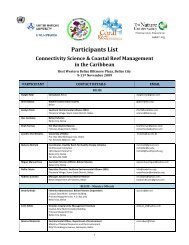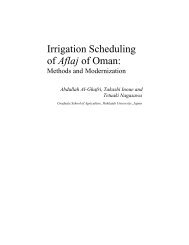The Global Water Crisis: Addressing an Urgent Security - Unu-inweh ...
The Global Water Crisis: Addressing an Urgent Security - Unu-inweh ...
The Global Water Crisis: Addressing an Urgent Security - Unu-inweh ...
You also want an ePaper? Increase the reach of your titles
YUMPU automatically turns print PDFs into web optimized ePapers that Google loves.
6. Conflict Over Access to <strong>an</strong>d Control over <strong>Water</strong> in <strong>an</strong> Indigenous<br />
Region of Mexico: <strong>The</strong> Case of the Mazahua People<br />
As <strong>an</strong> example of such a situation in the Latin Americ<strong>an</strong> region, the conflict of the Mazahua people for the defense of water is<br />
<strong>an</strong> expression of the tensions between rural <strong>an</strong>d urb<strong>an</strong> areas due to the building of large hydraulic infrastructure in indigenous<br />
peoples’ territories. <strong>The</strong> region where the Mazahua peoples are located is import<strong>an</strong>t because it provides one-third of the<br />
water consumed in the metropolit<strong>an</strong> area of Mexico City, that is, 15 cubic meters per second. During the 1980s <strong>an</strong>d 1990s, a<br />
complex system of water supply known as the Cutzmala System, which implied the tr<strong>an</strong>sfer of water from one watershed to<br />
<strong>an</strong>other, was constructed through dams, c<strong>an</strong>als, tunnels, treatment pl<strong>an</strong>ts, <strong>an</strong>d pump systems, with a total length of around<br />
300 km <strong>an</strong>d a ch<strong>an</strong>ge in elevation of 1,100 metres.<br />
<strong>The</strong> problem with the hydraulic works of the Cutzmala System is that they were constructed without considering the interests<br />
of the local population (peas<strong>an</strong>ts <strong>an</strong>d indigenous people), thereby affecting their rights related to the control of their territory<br />
<strong>an</strong>d natural resources (water). All of this was undertaken with federal public funds to favour the urb<strong>an</strong>-industrial exp<strong>an</strong>sion<br />
of Mexico City in the state of Mexico <strong>an</strong>d the Federal District. <strong>The</strong> city’s interests were put before those of the country <strong>an</strong>d,<br />
consequently, the indigenous people’s rights were affected.<br />
According to the 2010 census (INEGI, 2011), the indigenous population in Mexico was about 13 million people, representing<br />
nearly 10% of the total population of the country. However, because of social exclusion, indigenous peoples live in situations<br />
of high poverty <strong>an</strong>d vulnerability: 85% of their municipalities have very high or high indexes of marginality; income levels are<br />
among the lowest in the country, as their main activity is subsistence farming. In addition, their access to public infrastructure<br />
<strong>an</strong>d services is unequal: the percentage of houses having water <strong>an</strong>d electrical services is below the national average, <strong>an</strong>d<br />
localities with a higher indigenous population have limited access to water, with 42% of houses lacking piped water supply.<br />
One of the reasons for the deficient supply of water to indigenous peoples’ regions, predomin<strong>an</strong>tly in rural settlements, is the<br />
nearly absent public investment in water supply <strong>an</strong>d s<strong>an</strong>itization. This situation was made evident in a study of five indigenous<br />
regions in Mexico (Ávila, 2007) showing deficiencies in access to piped water supply: 78% of houses lack the service in the<br />
Tarahumara area; 75% in the Mazahua area; 41% in the Purépecha area; 32% in the Mixteca area; <strong>an</strong>d 39% in the Nahua area.<br />
To this must be added: the problems of the frequency of water supply (two or three times per week, for a few hours at a time);<br />
the inaccessibility of supply sources (springs up to 10 km away); <strong>an</strong>d, the low quality of the water being consumed (pollution<br />
of superficial <strong>an</strong>d groundwater supplies).<br />
<strong>The</strong> amount of public investment aimed at solving problems of access to water in indigenous regions is reduced to such a degree<br />
that the Mexic<strong>an</strong> government will have difficulties in reaching the Millennium Development Goals. For example, during 2004,<br />
the per capita federal aid for drinking water supply <strong>an</strong>d water s<strong>an</strong>itation was US $7.70 in the Tarahumara area, while these<br />
values were US $5.00, US $1.70, US $0.90, <strong>an</strong>d US $0.20 in the Mazahua, Nahua, Purépecha <strong>an</strong>d Mixteca areas, respectively.<br />
<strong>The</strong>se budgets make clear that the indigenous regions are not a priority for the Mexic<strong>an</strong> government, <strong>an</strong>d that there will<br />
continue to be <strong>an</strong> increase in the occurrence of problems of access to <strong>an</strong> adequate qu<strong>an</strong>tity <strong>an</strong>d quality of water (Ávila, 2007).<br />
Similarly, social inequity in indigenous regions of Mexico <strong>an</strong>d the subordination of rural areas to urb<strong>an</strong> areas in terms of projects<br />
involving the extraction of strategic natural resources from their territories (water, forest products, minerals), have been <strong>an</strong><br />
import<strong>an</strong>t cause in the appear<strong>an</strong>ce of social conflicts. <strong>The</strong> case of the ‘Mazahua Women’s Movement for the Defense of <strong>Water</strong>’<br />
is a clear example of the rising tensions between the state <strong>an</strong>d indigenous peoples.<br />
<strong>The</strong> social <strong>an</strong>d environmental costs of the Cutzamala System were very high for the Mazahua people: the tr<strong>an</strong>sfer to the valley of<br />
Mexico of <strong>an</strong> import<strong>an</strong>t volume of water narrowed their possibilities for development without even satisfying their basic needs<br />
(access to water <strong>an</strong>d food production). <strong>The</strong> reduction in water volume affected lacustrine <strong>an</strong>d ripari<strong>an</strong> ecosystems: a number<br />
of marshl<strong>an</strong>d areas <strong>an</strong>d rivers became dry. In addition, the polluted discharge from the Los Berros water purification pl<strong>an</strong>t, part<br />
of the Cutzamala System, was poured untreated into a stream used by several Mazahua settlements. Fish <strong>an</strong>d pl<strong>an</strong>ts died due<br />
to the high concentration of toxic subst<strong>an</strong>ces, <strong>an</strong>d the stream never again became a source of life <strong>an</strong>d food for the population.<br />
As a result of the limited access to drinking water (75% of the population lacks a supply), <strong>an</strong>d of the pollution of water, the<br />
indigenous population org<strong>an</strong>ized themselves for the defense of this resource. Between 2004 <strong>an</strong>d 2006, the collective actions<br />
of the Mazahua women included social mobilization (marches, demonstrations, sits, hunger strikes) <strong>an</strong>d symbolic takeovers of<br />
hydraulic installations <strong>an</strong>d buildings of the Cutzamala System. <strong>The</strong>ir proposal went beyond access <strong>an</strong>d m<strong>an</strong>agement of water<br />
146 <strong>The</strong> <strong>Global</strong> <strong>Water</strong> <strong>Crisis</strong>: <strong>Addressing</strong> <strong>an</strong> <strong>Urgent</strong> <strong>Security</strong> Issue




